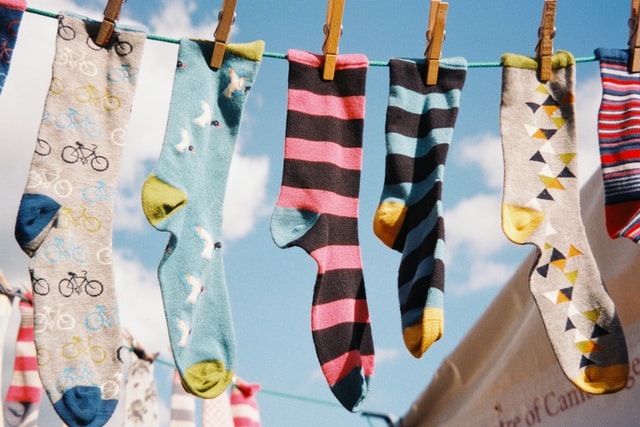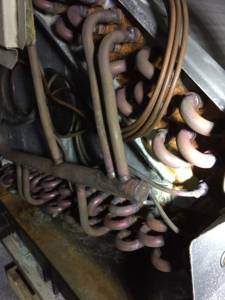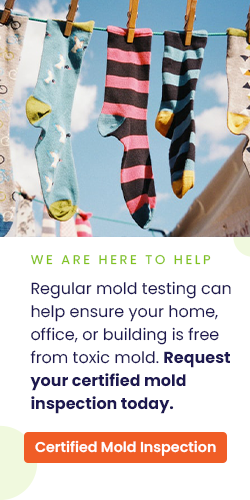If an indoor space appears to be free of obvious surface mold, many people erroneously assume that they are safe from mold-related illnesses. In reality, however, any structure with an HVAC system can harbor dangerous hidden mold. Mold and bacteria easily find a refuge within the sheltered coils of HVAC systems, accumulating until unpleasant odors and symptoms of illness become evident. By understanding how this phenomenon (dubbed “Dirty Sock Syndrome” owing to the musty odor it produces) happens, we can address and manage the possibility of dangerous concealed mold before a building’s occupants bear the brunt of chronic sickness.
How Does Dirty Sock Syndrome Occur?
Indoor HVAC coils, especially higher-efficiency coils, are prone to mold and bacteria growth because of the way they are designed and the fact that they intake large amounts of bacteria-laden indoor air. According to “Dirty Sock Syndrome: What It Is, How to Prevent It,” published in The News, HVAC systems also come ready-made with a store of bacteria: “Cooling coils, and other a/c components, are not made in sterile environments, meaning that microbes cover all of their parts along with a small amount of lubricant. During the first cooling event after installation, condensate brings life to the microbes, which initially use the lubricant as an initial food source. Recirculated air contains a variety of organic materials and microbial species that aide ongoing decay and microbial proliferation.”
The cycle of microbial growth in HVAC systems also tends to be self-perpetuating; microorganisms have short lifespans, and as such, the initial generation of bacteria inhabiting the HVAC system soon leaves a pile of miniscule carcasses which provide food for the next generation. The more generations there are, the more food there is, and the bigger the colony of mold-causing bacteria becomes.[1]
High-efficiency systems are particularly prone to Dirty Sock Syndrome because, as the surface area of the coil becomes more compact (as is the case with higher efficiency coils), the coil fin spacing gets progressively tighter (there are more fins per inch of coil). The depth of the coil may also increase due to the fact that manufacturers want to expose a greater amount of coil surface to the air stream in order to improve coil heat exchange (and in the process improve system efficiency). While this is indeed effective in terms of maximizing efficiency, as the coils grow in size, depth, and fin density, they become even more likely to trap bacteria and mold as they are providing more shelter for these microorganisms.
The Danger of Heat Pump Environments
Heat pump environments are particularly notorious for being susceptible to Dirty Sock Syndrome, for one simple reason: When the heat pump is in “heating” mode, the heating cycle is not hot enough to kill the microbes that grow on the coils when the system is in “cooling” mode and thus damp. This dampness is present because when the unit goes into defrost (“cooling”) mode, it relies on the use of liquid coolant to chill incoming air and effectively cool the building, producing a moist haven for any microorganisms or bacteria that were lying dormant prior. Most people do not realise that mold and bacteria growth are occurring until they put the pump back into its heating cycle, however, whereupon the microbes are warmed to such a level that they “off-gas” their odors. This produces the unpleasant smell that has been associated with Dirty Sock Syndrome since the term was first coined in the 1970s.
The above-described growth cycle is especially likely to occur during the transitional seasons—spring and fall—when the HVAC system performs heating operations in the morning hours and cooling operations around noon; this can produce moisture from noon onwards, fueling mold growth for up to 16 hours.[2]
One of the most dangerous aspects of heat pump environments is that they produce only transient odors; many people find that the odor comes and goes, and as such, they believe the cause of the odor is itself not a permanent issue and nothing to be worried about. In reality, however, the problem is actually worsening all the time, and the occasional cessation of odors is due to how the system functions. Not only does the smell cease when the system is in cooling mode, when it gets very cold and the outdoor temperature drops below the thermal balance point of the heat pump, supplemental heat for the heat pump is energized. At this point, the discharge temperature of the system is likely hot enough to kill off many of the microorganisms and/or bacteria as they move from the air handler or furnace. However, while this provides temporary relief, as soon as temperate weather returns, the bacteria is typically able to repopulate. Meanwhile, it stresses the HVAC system year after year, doing cumulative damage to it.
How Bioslime Impacts The Coils on an HVAC System
A coil that’s covered in bioslime (the name given to the combination of moisture, bacteria, mold, dust and other contaminants that coats HVAC coils) cannot perform proper heat transfer and therefore consumes far more energy than an HVAC system with clean coils. People who have invested in high-efficiency HVAC systems therefore ironically end up with very low-efficiency systems, creating a costly and frustrating mystery until the issue of Dirty Sock Syndrome is discovered and addressed. Shockingly, an HVAC system operating with dirty coils can use up to 37% more energy than a system with clean coils. HVAC systems infested with bioslime also suffer from a reduced cooling capacity and may cool up to 30% less efficiently.[3]
As mentioned above, Dirty Sock Syndrome may even harm one’s HVAC system; because dirty coils increase operating pressure, temperatures become higher within the system, eventually leading to the breakdown of the compressor’s lubricant, resulting in the failure of the compressor. This often necessitates a costly repair.
How Dirty Sock Syndrome Impacts Human Health
According to the World Health Organization (WHO), 60% of all indoor air quality problems and allergies are likely to be mold related. Some indoor air quality diagnosticians and practitioners actually believed that this is an underestimate, and frequently report that the figure may be as high as 80%. Research also suggests that the increased usage of HVAC systems almost directly parallels the subsequent increase in allergies and indoor air quality issues within buildings.[4]
Though not all cases of Dirty Sock Syndrome wind up being life-threatening or seriously debilitating, it’s impossible for the average layman to tell whether or not an individual case of Dirty Sock Syndrome is likely to be dangerous. This is because the risks posed by Dirty Sock Syndrome vary widely depending on what kinds of mold and bacteria are growing within the HVAC system, and harmful mold cannot be differentiated from harmless mold through any means other than professional testing. As many forms of mold pose at least some health risks, it’s advised that people always take Dirty Sock Syndrome seriously and have the problem treated as quickly as possible.
If the mold and bacteria present are dangerous, they can quickly affect everyone within the building. As mold and bacteria grow on coils and in drain pans, they are carried through the ducts by the action of the HVAC system and fill occupied spaces in the home or office. From there, the toxins present in the mold can produce serious and sometimes even life-threatening reactions, such as allergies (resulting in chronic rhinitis and other complications), asthma, Legionnaires Disease, hypersensitivity pneumonitis, and even bleeding lung disease.[5]
Mold exposure also carries long-term health risks which are only now being investigated by science. Mold produces what are known as “Microbial Volatile Organic Compounds” (MVOCs); these are the gases which produce the musty odor commonly associated with mold. MVOCs are comprised largely of chemicals; in fact, laboratory experiments have identified over 200 compounds within MVOCs. Some of these chemicals, such as aldehydes, benzenes, and tulolenes, are not only irritating to the eyes, mucus membranes, and respiratory system, they are also potent carcinogens.[6]
Treating Dirty Sock Syndrome
When it comes to treating Dirty Sock Syndrome, early intervention is key; once mold spores and bacteria have penetrated deeply into the system, cleaning alone may be insufficient to remove them. As this stage, one may have to replace the unit’s coils, and if that does not take care of the problem, the only solution is to replace the entire HVAC system—an extremely costly operation.[7] You should therefore never “wait and see” if you begin to detect the telltale organic, musty odors produced by mold and bacteria—call in a professional immediately.
Never attempt to clean an HVAC system yourself; many common “DIY” remedies, such as bleach, can damage the components of your HVAC system.[8] Seek out professional guidance before embarking on any care or maintenance program at home. A professional will usually:
- Identify the nature of the problem. He or she will diagnose whether or not you have Dirty Sock Syndrome, and if a toxic mold issue is suspected, he or she will have the mold tested so its type can be verified.
- Clean the evaporator coil thoroughly with a non-acid coil cleaner and completely clean out the drain pan. A professional will have access to specialized low-acid cleaners which are effective at killing mold, but which do not damage the delicate inner workings of the HVAC system (among other cleaning methods). While cleaning alone seldom takes care of the problem permanently, it may be enough to keep the HVAC system problem-free for the duration of one year. Cleanings will therefore need to be repeated annually. (Note that this type of operation will only be sufficient if mold and bacteria have not penetrated beyond a surface level. It may also be insufficient in certain climates.)
- Suggest that the coil be coated with an antimicrobial agent. This will require that the coil be removed and shipped to the manufacturer of a coating service. The coating material contains an antibacterial agent which prevents mold regrowth and usually comes with a warranty—be sure to check how long this warranty lasts and prepare for future re-applications of this coating as necessary. It’s essential to replace antimicrobial coatings in a timely manner as if you do not, the inert ingredients of the coating and the many dead carcasses of the last generation of bacteria can easily provide a food source for a new generation, allowing the infestation to return with a vengeance.
- Suggest a UV treatment. While there is some debate around UV treatment as some indoor air quality experts feel it does not penetrate the HVAC system thoroughly enough, it remains a viable solution, one that some homeowners may feel is preferable to antimicrobial coatings alone. UV treatment makes an excellent supplement to cleaning and coating as unlike cleanings and coatings, it’s permanent—so long as it is installed and operated correctly, it will be able to kill bacteria all day, every day, until the UV treatment system is removed or damaged. This greatly minimizes the mold and bacteria’s chances of re-infesting the HVAC system as soon as the mechanisms of treatment discussed above reach the end of their period of efficacy.
If all of the above measures prove ineffective, the next step will be to replace the coils and attempt to maintain the new coils in such a way that the problem does not return, e.g. with annual professional inspection and cleaning. If even this fails and your HVAC system requires a complete replacement, you may wish to switch away from using a heat pump system and install a gas furnace; because gas furnaces produce far more heat than heat pump systems do, they are excellent for keeping mold at bay.[9]
[1] Dirty Sock Syndrome: What It Is, How to Prevent It, http://www.achrnews.com/articles/127583-dirty-sock-syndrome-what-it-is-how-to-prevent-it
[2] Dirty Sock Syndrome: What It Is, How to Prevent It, http://www.achrnews.com/articles/127583-dirty-sock-syndrome-what-it-is-how-to-prevent-it
[3] Coil Cleaning, https://www.goodway.com/coil-cleaning.htm
[4] A cure for the dreaded ‘Dirty Sock Syndrome’? http://www.achrnews.com/articles/114991-a-cure-for-the-dreaded-dirty-sock-syndrome
[5] A cure for the dreaded ‘Dirty Sock Syndrome’? http://www.achrnews.com/articles/114991-a-cure-for-the-dreaded-dirty-sock-syndrome
[6] MVOCs http://blackmold.awardspace.com/mvocs.html
[7] A cure for the dreaded ‘Dirty Sock Syndrome’?http://www.achrnews.com/articles/114991-a-cure-for-the-dreaded-dirty-sock-syndrome
[8] http://hvac-talk.com/vbb/showthread.php?913532-Don-t-use-Bleach
[9] Dirty Sock Syndrome: What It Is, How to Prevent It, http://www.achrnews.com/articles/127583-dirty-sock-syndrome-what-it-is-how-to-prevent-it







